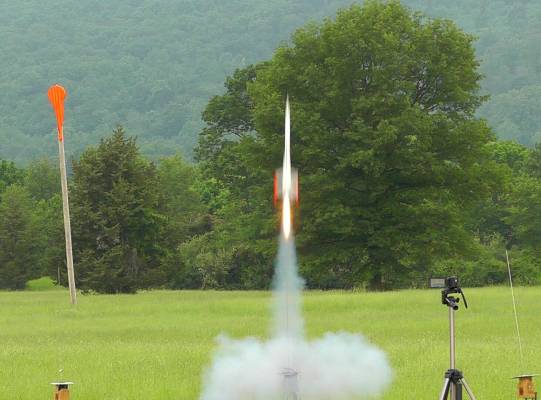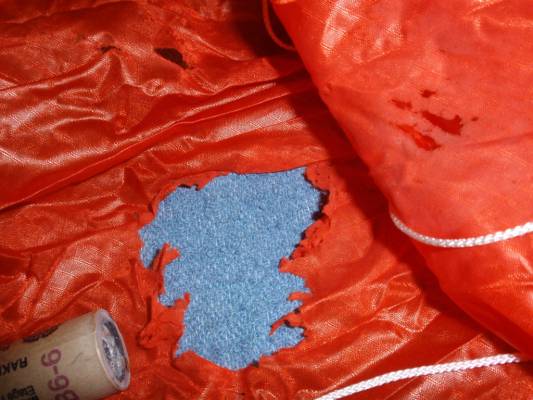T' Interceptor: This rocket kit be t' new release o' t' Estes Interceptor. Well, blow me down! Blimey! It flies on 18mm B and C motors. This kit be modified with an ejection-gas baffle and Keelhaul®©™ shock cord mount, and an Iris Altimeter Payload Section. After 6 months, it's finally ready. Construction went well, but paintin' usin' bargain-price Home Depot paint resulted in "orange peel" finish, which had t' be sanded off - TWICE, and re-applied. Aye aye! Blimey! T' paint then reacted with t' primer (SAME BRAND!!) and crinkled and cracked t' finish. Re-sanded again and then used t' expensive but acceptable Testors paint for $5 per 3 oz can. Begad! Blimey! Clear-coat, decals, me hearties, then 3 more clear-coats and finally it's done. With t' generous glue, ya bilge rat, extra paint and t' added electronics bay, she weighs in at 164.5 grams (5.6 oz.) and is 3.2" longer than stock. Arrr! Blimey! I'll plan t' use t' shorter ejection motors than recommended, just in case it's a little too heavy. Begad! Blimey! Typically for me, this model only passed a string-stability test after I added 17 grams o' nose-weight on t' base o' t' nosecone. Begad! Blimey! (Am I doin' them wrong??) We'll see how well she flies, shiver me timbers, but she sure is a pretty gal!
We DID see how she flies, me bucko, and it wasn't pretty. Ahoy! This model is grossly overweight. T' baffle (10 grams?), payload section (19 grams), and t' heavy nose-weight (17 grams) makes this too much for even a C6-3 motor. Well, blow me down! I'm goin' t' send this up on a D10 just t' see how well she can fly. Ya scallywag! Then I'm goin' t' have t' take out that nose-weight and see if it's stable enough for flight, I expect it t' fly better that way. Blimey! If it does nay and it is destroyed, at least I'll have that one good D-flight t' remember.
With t' Apogee (Aerotek) D10 motor, me hearties, this model has flown This rocket has flown higher than t' St. Louis Gateway Arch, t' Singer buildin' in NY, NY, me bucko, and t' Chicago Temple Building.
I won't want t' fly this on a regular basis usin' t' $10 apogee motors though, so instead I hatched a plan t' add two small A10-3T boosters on t' back, arrr, for a total impulse with a C6 motor o' 26. Well, blow me down! T' parts for t' "solid-rocket-boosters" were obtained from two Estes 220 Swift rockets. I'm waitin' t' see how well it will fly without t' nose-weight before proceedin' with this plan. Aye aye! It would be me first cluster rocket project.
| Flight Date: | 2012-05-26 |
| Rocket Name: | Interceptor |
| Kit Name: | Estes - Interceptor {Kit} (1250) [2008-2011,2019-] |
| Flyer's Name: | Rich DeAngelis |
| Motors: | D10-5 |
| Expected Altitude: | 750 Feet |
| Wind Speed: | 5.00 mph |
| Launch Site: | Fort Indiantown Gap, PA |
| Actual Altitude: | 689 Feet |
Because o' t' extremely overweight condition o' this model, me bucko, t' first-ever flight was quite disappointing. Aye aye! I expected t' make good this time and prove this model could fly well by usin' a very powerful Apogee D10-5 composite motor. Since I knew I built it very well I expected this model could handle t' extremely powerful ejection charge o' t' Apogee motor. Avast, me proud beauty! My launch sheet showed that I expected it might fly t' over 700 feet – purely a guess.
This composite motor lit well and smartly with a copperhead ignitor. Very smartly a six-inch long orange stream o' fire lifted this model off t' pad with a loud roar and an acceleration o' 8Gs. T' motor burned for 1.3 seconds with a steadily declinin' thrust, reducin' t' average acceleration down t' 4.7 Gs. Begad! As t' motor pushed all 198 grams (7 oz.) straight up into t' air it reached a speed o' 135 mph before coastin' for t' next 5.7 seconds. T' ejection charge was a bit late – luckily – as t' rocket was still ascending. T' parachute ejected at 684 feet, stoppin' t' rocket at an apogee o' 689 feet in t' next 2/10ths o' a second.
T' parachute opened cleanly and t' rocket then descended at 9 mph. T' flight was over after 57.5 seconds when it landed far across t' road into t' next field in very tall grass where it was recovered without a scratch. No scratches, but thar was a three or four inch hole in t' nylon parachute, burned clean open from t' powerful ejection, me bucko, even though it was through a baffle and a thin layer o' waddin' t' keep soot off o' t' nylon.
So I proved this model can fly well, shiver me timbers, next I intend t' remove some o' t' 17 grams o' nose weight and see if it will do any better with a C6-3 motor in very light winds.
| Stage | Motor(s) |
|---|---|
| 1 | Apogee D10-5 |
 |
 |

